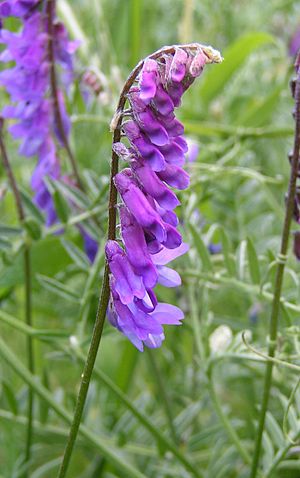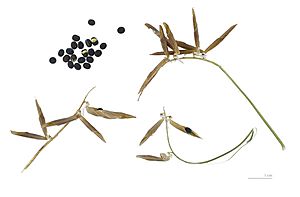Tufted vetch facts for kids
Quick facts for kids Tufted vetch |
|
|---|---|
 |
|
| Scientific classification |
Vicia cracca, also known as tufted vetch, cow vetch, or bird vetch, is a type of flowering plant. It belongs to the pea and bean family, called Fabaceae. This plant originally comes from Europe and Asia. However, it has spread to other parts of the world, like North America, where it is now a common plant found in many places. You can often see it growing in areas where the ground has been disturbed, such as old fields or along the sides of roads.
Contents
About Tufted Vetch
Tufted vetch is part of the pea family. It grows like a pea plant, with stems that can reach up to 150 centimeters (about 5 feet) long. This plant is a perennial, meaning it lives for more than two years. It has special tendrils that look like small ropes. These tendrils grow from the tips of its leaves. When a tendril touches another plant, it wraps around it tightly. This helps the vetch climb, but it can also make it harder for smaller plants to get enough sunlight.
A single tufted vetch plant can grow up to 2 meters (about 6.5 feet) tall or long. It has a white taproot that can go deep into the ground, sometimes as far as 1 meter (about 3 feet). The leaves are 3–8 centimeters long and have 8–12 pairs of small leaflets, each about 5–10 millimeters long.
This plant grows quickly and produces many flowers. From late spring to late summer, it sends out clusters of 10 to 40 purple or violet flowers. These flowers are shaped like small peas and hang down from the plant. Bumblebees especially love to visit these flowers. After the flowers fall off, tiny bright green seed pods start to form. These pods are 10–20 millimeters long. Tufted vetch looks a lot like another plant called hairy vetch (Vicia villosa), but you can tell them apart because tufted vetch has a smooth stem.
The seed pods are about 2 centimeters long and hold 6 to 8 seeds inside. They look like very small pea pods. The tiny seeds are ready when the pods turn black. Before they are ripe, the seeds are swollen and green. The seed pods can be light brown to dark brown with black spots.
Where Tufted Vetch Grows
Vicia cracca is naturally found in Europe and Asia. It has also been brought to many parts of North America, where it now grows widely.
Tufted Vetch's Home
You can often find tufted vetch growing in places where the ground has been disturbed, like empty lots or construction sites. It also grows well in hedges and other wild areas.
Uses of Tufted Vetch
Tufted vetch is very useful! Farmers often grow it as a forage crop to feed cattle. It's also good for the soil because, like other leguminous plants, it helps add important nutrients like nitrogen to the ground. This process is called nitrogen-fixing. Bees and butterflies also really like tufted vetch because its flowers provide them with nectar. This plant can also be used to help stop erosion, which is when soil is washed away by wind or water.
People who own pet birds, like budgerigars, sometimes give them tufted vetch as a healthy food. Birds especially enjoy the seeds, but they might also eat the leaves.
Because tufted vetch is good as a cover crop (a plant grown to protect the soil) and a source of green manure (plants grown to be plowed back into the soil to make it richer), it has been planted in many places far from where it originally grew. In North America, it has become a common plant from southern Canada down to upstate South Carolina. In some areas, it is considered an invasive plant, which means it can spread too much and might take over areas where native plants used to grow. Because of this, its sale might be controlled in some places.
Tufted vetch can sometimes cause problems in areas where it is not native. It might grow so much that it crowds out native plants, especially in places where the soil has been disturbed. This is a concern in projects that are trying to bring back natural habitats, like prairies, in North America.
See also
 In Spanish: Arveja silvestre para niños
In Spanish: Arveja silvestre para niños



